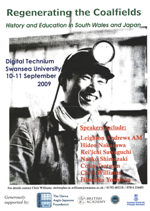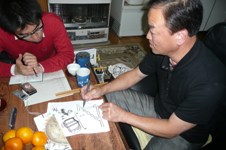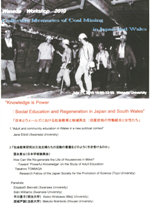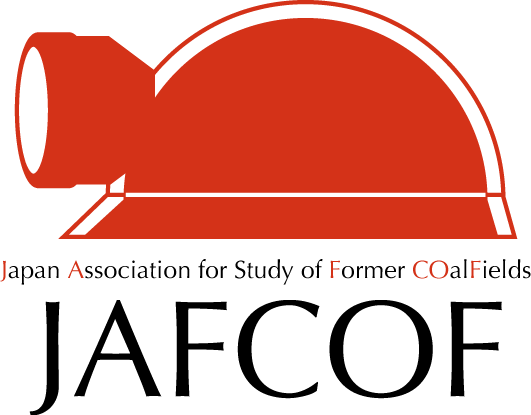Link
Research project: 'Rescue and Archives of Materials for Networking-typed Regeneration of Former Coalfields' (corresponding page of National Institute of Informatics--> http://kaken.nii.ac.jp/ en/p/21243032)
1.Past Research Results
Papers
- September, 2009 "Sociological Theory and Methods" vol.45: Hideo Nakazawa and others,'The Necessity of Archival Science in Social Research' (in Japanese)
- March, 2009 "Social Information" vol.18 (issue 2): "Report on Society for Study" Chris Williams 'The South Wales coalfield: history and regeneration' and other
- February, 2010 "'Material Compilation of the Yubari Research-'Change of Local Industries and Social Classes' edited by Tetsuji Fuse" Report on Research Project by Grants-in-Aid for Scientific Research (in Japanese)
- March, 2010 "Social Information" vol.19 (issue 2): "Report on Society for Study" Hideo Nakazawa,'New Research Agendas on Former Coalfields in Japan; After the winding wheel has stopped' and other (in Japanese)
Newspaper Articles
- September 16, 2010 Sorachi Edition of The Hokkaido Shimbun Press.
- August 8~9, 2009 The Hokkaido Shimbun Press.
2.Extracts of Applications /Progress Reports
Below are extracts from 'Preliminary Memo on our Plan' which we submitted to JSPS, Japan Society for the Promotion of Science (independent administrative institution which controls Grants-in-Aid for Scientific Research) (October, 2008), 'Application' which we submit every fiscal year after adoption (in May of each year) and 'Progress Report' which we submit every fiscal year (in March of each year).
'Research Purpose' from the application of FY 2009

flier of Wales Symposium
JAFCOF's research project is a foundational work to broaden general research of Joban's former coalfields, which has been giving bearing fruit, to comparison with domestic similar regions such as Sorachi, Hokkaido, furthermore to comparison internationally in cooperation with South Wales, the U.K. We are going to rescue and integrate materials of industrial heritage which is critically scattered and lost in Sorachi and produce archival results for local regeneration. Simultaneously, we will establish network among scholars and workers of domestic former coalfields and make preparations to shift to matured comparative historical sociology of former coalfields in the following 5 years. Concrete works are mainly sober works such as making chronologically-ordered geographic datum of statistics which concerned local governments do not own at present, contacting key persons, confirming where retired employees live now, and searching, copying and sorting documentary records. But, when these projects make progress, enormous documents and electronic datum on ups and downs of colliery society in Sorachi region should be integrated and it would be one of industrial heritages which we can show as 'recollection of coalmine' archive. So we can continue discussing comparative study and an outline, viewpoints and strategies for actualization of regeneration with local people. We believe true local regeneration is not to continuously make expensive public facilities to maintain but to train software and personnel based on the history and the recollections of regions and make networks with other regions. This project is the touchstone.
JAFCOF is the pioneer that organized the comparisons among former coalfields and realized a research project which includes even potential range of international comparisons. Until now the study of former coalfields tends to be done by local universities individually according to regional peculiarity. Our attempt to integrate them is simply stimulating. While former coalfields are having hard time of bankrupt, it is urgent and significant to work on. In the cooperation with local NPOs and others in various ways, we can expect their contribution to know-how, past achievements and networking not only for former coalfields but also overall local regeneration because it is a new type of a research model which could impact directly to societies. In addition, we are featured by many graduate students and scholars writing doctoral dissertation to join across the country, which is greatly significant to train young scholars.
'Research Operation Plan for this Fiscal Year' from the Application of FY 2009
For the above purposes, JAFCOF's tasks for 5 years are to rescue related materials which could be more scattered and lost, to construct (electronic) archives of our own and to create statistical and geographic datum to grasp chronological order of local general situation. In keeping with it, we will grasp the whole image, methodology and the general situation of Sorachi in this fiscal year. With use of our know-how accumulated through the study of Joban, the works for the first fiscal year will be; 1. To grasp whereabouts of coal-mining related people, 2. To start contacting key-persons, 3. To have trial and error for grasp of the general situation of chronological-ordered regional transitions and 4. To determine the priority of materials to rescue.
- Preparation Work to Grasp Whereabouts of Related People
We will find out connections to know where people who worked for coalfields moved after they retired. We will accumulate know-how to grasp whereabouts of related people by asking research collaborators and advisors for provision of information and asking local people who participate in related events each time. - Contact to Key-Persons
It is important, too, to make interviews to key-persons with the primary purpose of grasping whereabouts of materials and related people. We will begin getting contact with people who were in managerial positions in local governments, labor unions, companies and the Chamber of Commerce and Industry. There is possibility that information on the materials we must rescue emerges. - To Grasp General Situation of Chronological-Ordered Regional Transitions
While it is necessary for goal achievement to grasp chronological-ordered regional transitions and express by maps, chronological tables and development views, the existence of former coal-mining companies are so big in Sorachi that the local governments commonly tended to hardly make these datum. Accordingly we need to reproduce them from statistical datum by Japan and Hokkaido, newspaper articles, rescued materials and interviews, on which will keep working for the whole 5 years. While we outsource this work to a research agency in Sapporo, Tamano will attempt a reproduction by making use of mesh data by a national census and offices' statistical surveys. In addition, Shimazaki and Sawaguchi expect to make a reproduced map of Sorachi version like the one of Joban region they made (by commissioning Dai Nippon Printing Co., Ltd. to reproduce the locations of coalmining related facilities on a map, applying Google Map). - To Decide the Priority of Materials to Rescue
In Sorachi, there are many flocks of materials, including the above mentioned ones on Sumitomo Akabira Coal Mine, which will be scattered and lost unless someone collects them and make at least catalogs. After the next fiscal year, we will decide the priority, considering strategy and order for preservation based on the information on whreabouts of emerged materials.
The Progress Report of FY 2009
JAFCOF's project aims to rescue and integrate materials of coalmining heritage in Sorachi, Hokkaido, and produce archival results to help with local regeneration. It is important, too, to construct cooperative relationships with domestic and overseas former coalfields to rank each material. Based on our fundamental belief that the true local regeneration is not to continuously make expensive public facilities to maintain but to train software and personnel based on the history and recollections of regions, we will open up epoch-making study research both academically and practically through archiving and networking.
In FY 2009 as the kickoff period, we aimed to draw a whole image, to grasp the methodology of works and to make a beginning networking. To add chronological and geographical datum that the local governments do not have at present, we realized these below as works to draw a whole image of the regions; 1. To create a map of population change by mesh data of national censuses, 2. To create a map of transition of coal mine residence in limited district and 3. To create a projection drawing of coalmining facilities only in Horonai colliery on Google Map.In addition, we conducted these below as works to grasp the methodology; 4. To begin contact and interview to key persons in Akabira district, 5. To confirm the information on whereabouts of each material and arrange preceding researches and 6. To prepare the system of resource management as the center of executive university (Chuo University). We will continue these above works next fiscal year and update the state of progresses one by one over the Web when it is possible to announce.

inquiring survey
In the aspect of networking, we held a symposium in Sorachi in August, investing another grant, too, and one in Wales in September, in which we could materialize the cooperative relationship among former coalfields and met with a local response of being picked up in the Hokkaido Shimbun Press. Through the preparation of symposiums, we could successfully build cooperative relationships with NPOs, local governments and universities in Sorachi and Wales. The results of Sorachi symposium will be reported in the bulletin "Social Information" of Sapporo Gakuin University.
Holding meetings which almost all the investigators and the cooperative members attend three times within this fiscal year for the preparation and summary of the above activities, we shared purposes and tasks of our research group, attempted theoretical deepening and concrete the activities of and after next fiscal year. Four doctoral graduate students constantly attended, so that we could say we significantly contributed to train young scholars.
'Research Purpose' from the Application of FY 2010
JAFCOF's project originally targets are; 1. To rescue and integrate industrial heritage related materials in Sorachi which is critically scattered and lost, 2. To produce archival results for local regeneration and 3. Simultaneously, to establish networks among scholars and workers of domestic and overseas former coalfields and make preparations to shift to matured comparative historical sociology of former coalfields in the following 5 years. Accordingly, with the progress of our project, since documents and electronic materials about ups and downs of colliery society will be integrated, an outline, viewpoints and strategies to comparative study and practical regeneration will be plentifully discussed and it is expected that a certain archives will be constructed in the end. Concrete works are mainly sober works such as making chronologically-ordered geographic datum of statistics which concerned local governments do not own at present, contacting key persons, confirming whereabouts of retired employees, searching, copying and sorting documentary records. Through these sober works, we will train software and personnel based on the history and recollections of regions and form the foundation for networking with other regions.
JAFCOF is the pioneer that organized the comparisons among former coalfields and realized a research project which includes even potential range of international comparisons. Until now the study of former coalfields tended to be done by local universities intermittently. Our attempt to integrate these is simply meaningful. While former coalfields are having hard time of bankrupt, it is urgent and significant to work on. In cooperation with local practitioners in various ways, we can expect its contribution to know-how, past achievements and networking not only for former coalfields but also overall local regeneration because it is a new type of a research model which could impact directly to societies.
'Research Operation Plan for this Fiscal Year' from the Application of FY 2010
For the above purposes, JAFCOF's tasks for 5 years are; (a) To integrate, rescue and sort the information on whereabouts of materials, (b) To construct (electronic) archives of our own, (c) To create datum for the grasp of chronological order of general situation and d. To form networking domestically and internationally and make comparisons. Regarding (a)~(c), although we worked on to some degree (refer to The Progress Report of FY 2009), we will continue working on the sober tasks below this fiscal year falling on the 2nd year; a-h22) To exchange information with key persons and related people who contact us and rescue materials when needed, b-h22) To integrate and collect the information on whereabouts of documents and to prepare for electronic archives by digitalizing and c-h22) To investigate the life history of former coal miners in Akabira and to conduct the follow-up survey of retired employees in the group of Fuse Tetsuji's 'Yubari Research from 1973 to 1983.'
On the other hand, (d) is the purpose in the middle term and was not seen in the application for grants of FY 2009. But, since the comparisons among domestic former coalfields (especially Sorachi -Joban -Ube) are being prepared with unexpectedly favorable progress of networking, we are going to pursue the result in this aspect preponderantly and would like to report the result in English in the symposium (at Swansea University) planned in Wales in March, 2011, after each investigator researches in Japan. Accordingly, since the introduction of preceding study in Japanese is important, too, for networking, we will allocate part of the grants for Japanese-English translation. The grants will cover part of proper items of expenditure, too, because the symposiums are for the purpose of networking, although mainly other grants (grant for bilateral project of Japan Society for the Promotion of Science, school grant in Waseda University and so on) will cover both this Wales symposium and a joint symposium of Japan and the U.K. planned in July at Waseda University.
We will report the researches result in several scientific societies. In addition, we aim to make public the manuscript in English of the symposium held in Wales in September, 2009, the above comparative results of domestic former coalfields and results of life history in Akabira as a working paper series. Also, we will concretely consider starting home page to announce latest results of archiving as a study group.
The Progress Report of FY 2010
In the 2nd year, the FY 2010, we successfully started the work of concrete archiving and networking based on the capital of the human relationships built in the first fiscal year.

flier of Waseda Workshop
in 2010
In the aspect of archiving, we obtained great success in 3 missions described in the application for the grants at the beginning of the fiscal year. (a-h22) We conducted four cases of rescuing materials from key persons and related people. We will make catalogs of the rescued materials next fiscal year. (b-h22) We are in process of issuing a booklet which shows integrated, collected and digitalized information on documents (whereabouts), including the above points, next fiscal year. (c-h22) Regarding investigating life history of former coal miners in Akabira and conducting follow-up survey of retired employees in the group of Fuse Tetsuji's 'Yubari Research from 1973 to 1983,' we did about 60 people in total intensively mostly from summer to fall and are going to publish a booklet which reports interimly within this fiscal year.
In the aspect of networking, we held a symposium at Waseda University in July and one in Wales in March in which we realized the comparison of international networking among coalfields. Moreover, we could actualize the unprecedented interchange between key persons of Joban and Ube district, Yamaguchi, with our support. We are preparing to translate related documents in Japanese into English.
Holding meetings two times which all investigators attend at the beginning and the end of this fiscal year for preparation and summary of the above activities, we shared purposes and tasks of our research group and attempted theoretical deepening. Since the line-up of investigators and graduate students is increasing, we could way we are significantly contributing to train young scholars.

